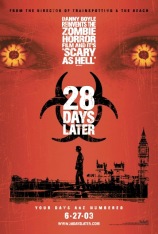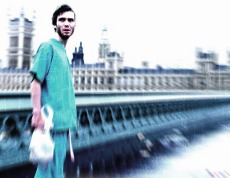|
28 Days Later
|
| |
 |
UK/USA/Netherlands, 2002. Rated R.
112 minutes.
Cast:
Cillian Murphy, Naomie Harris, Megan Burns, Christopher Eccleston, Brendan
Gleeson, Noah Huntley
Writer: Alex Garland
Music: John Murphy
Cinematographer: Anthony Dod Mantle
Producer: Andrew Macdonald
Director: Danny Boyle
LINKS
|
 hosts
of Mars, Resident Evil—are
zombie movies becoming popular again? Or have they never gone away, maintaining
a devoted cult following ever since George A. Romero launched the genre more
than thirty years ago with Night of the Living Dead? Personally, I don't
like them. They're all pretty similar, beginning with somebody doing something
stupid that tampers with the natural order of things, releasing the shambling,
man-eating corpses into the world of the living. As with other horror/thrillers,
the condition is always highly infectious, so that the heroes—facing overwhelming
odds, of course—are always in danger of becoming monsters and turning against
their comrades. Some of them inevitably do. Beyond that, they're ninety minutes
to two hours of blood, gore, and mayhem.
hosts
of Mars, Resident Evil—are
zombie movies becoming popular again? Or have they never gone away, maintaining
a devoted cult following ever since George A. Romero launched the genre more
than thirty years ago with Night of the Living Dead? Personally, I don't
like them. They're all pretty similar, beginning with somebody doing something
stupid that tampers with the natural order of things, releasing the shambling,
man-eating corpses into the world of the living. As with other horror/thrillers,
the condition is always highly infectious, so that the heroes—facing overwhelming
odds, of course—are always in danger of becoming monsters and turning against
their comrades. Some of them inevitably do. Beyond that, they're ninety minutes
to two hours of blood, gore, and mayhem.
Now it's Trainspotting's
Danny Boyle's turn to take a crack at the genre with 28 Days Later. In
this case, the zombies are not actually zombies, even though they may as well
be. Apart from the fact that they are much, much faster, they look and act like
zombies, and are just as contagious. They are people infected with a laboratory-developed
virus called—get this—Rage. That's right, some misguided fools have
taken rage and distilled it to a tangible essence. These are some pissed off
pseudo-zombies. Why they don't just rip each other to shreds, if they're so
angry, is beyond my comprehension, but if you're going to get all logical about
stuff like that, you should skip the movie entirely.
Silly as it sounds, 28 Days Later does manage to be the best zombie
film I've ever seen. Of course, that's kind of like saying the French are the
best third-rate engineers in the world, as Arthur C. Clarke wrote in Childhood's
End. It doesn't mean the film is a masterpiece, but it does work, and surprisingly
well.
This is not a splatter movie per se, though there is enough splatter
to satisfy fans of cult horror and make others look away. The drooling, slathering
creatures aren't as important to Boyle as the human elements of his story. How
would a real person react if he woke up in a hospital bed to find all
London trashed and deserted (almost) save for himself? What would it take to
survive under those conditions? What kind of bonds do people form under such
extreme conditions? What happens to male/female relations? If someone you love
becomes infected and you have twenty seconds to kill him, what do you do?  Despite
the preposterous premise, these are authentically human characters. You believe
their responses and behavior. It helps that the actors, mostly unknowns, perform
credibly.
Despite
the preposterous premise, these are authentically human characters. You believe
their responses and behavior. It helps that the actors, mostly unknowns, perform
credibly.
The Enraged are symbolic (duh), being an extreme manifestation of an emotion
that resides within us all. Take, for example, the chimpanzees being infected
with "rage" at the beginning of the film, ostensibly so that scientists can
find a cure for this enduring and destructive foible. As part of the experiment,
the chimps are strapped to chairs and forced to watch monitors of human destruction
and violence. Yes, the rage-afflicted zombie substitutes are scary. But 28
Days Later is even more frightening for what human beings end up doing to
one another. In the end, most are no different from the monsters who hunt them.
Unlike the The Beach, which boasted a large budget and pristine picture
quality, Boyle has made 28 Days Later as a low-budget, independent film.
It is filmed in what appears to be digital video, and the picture quality is
for shit, particularly the color definition. Boyle does seems aware that his
movie looks like crap, even substituting what seems to be an Impressionist painting
of a field for an actual field, with a real automobile driving along the top
of it, on the horizon line. If photographers can become famous for their grainy,
low-resolution images, then, you might ask, why can't those images be strung
together in a live-action movie?
Given the post-apocalyptic nature of the film, you could argue that Boyle's
visual style works to a point. He has created a grungy look, and dropped frames
out during editing of the action sequences to create the accelerated effect
we saw in Gladiator. He occasionally
shoots from the perspective of the Enraged, similar to Spielberg in Jaws,
which is effective. But it seems to me that no matter how you defend it, a crappy
looking film is still a crappy looking film. At least Boyle remains a director
with a good sense of music, as he demonstrated in The Beach and Trainspotting—in
this case, heavily electronic music, at times atmospheric and other times pulsating.
28 Days Later has been released in theaters in the United Kingdom, and
is doing well, but it is still waiting for U.S. distribution, probably because
Boyle's supposedly promising career went into a tailspin after Trainspotting.
28 Days Later is not good enough to put him back on the "It" list of
directors, but it might earn him another shot at the big time. In the meantime,
28 Days Later should make it at least to a video release in the States,
and is far more worthy of your time than Milla Jovovich's laughable fighting
machine in some threatened Resident Evil sequel. [Ed. note—This
film obtained U.S. distribution and was released in June 2003.]
Review
© December 2002 by AboutFilm.Com and the author.
Images © 2002 Fox and its related entities. All Rights Reserved.

 Despite
the preposterous premise, these are authentically human characters. You believe
their responses and behavior. It helps that the actors, mostly unknowns, perform
credibly.
Despite
the preposterous premise, these are authentically human characters. You believe
their responses and behavior. It helps that the actors, mostly unknowns, perform
credibly.
